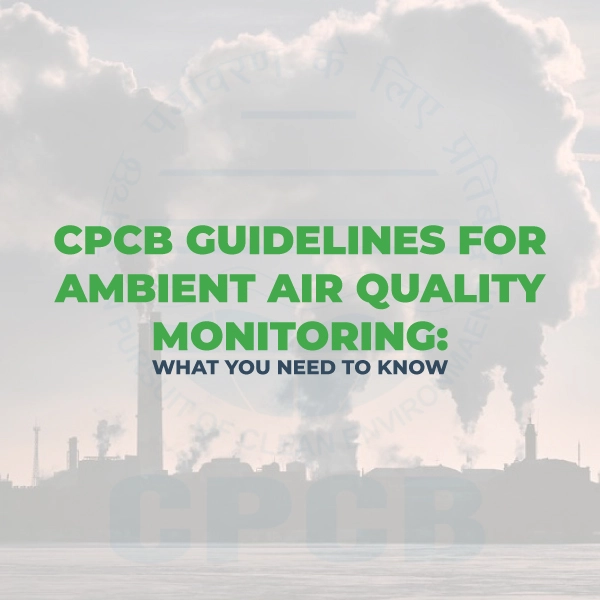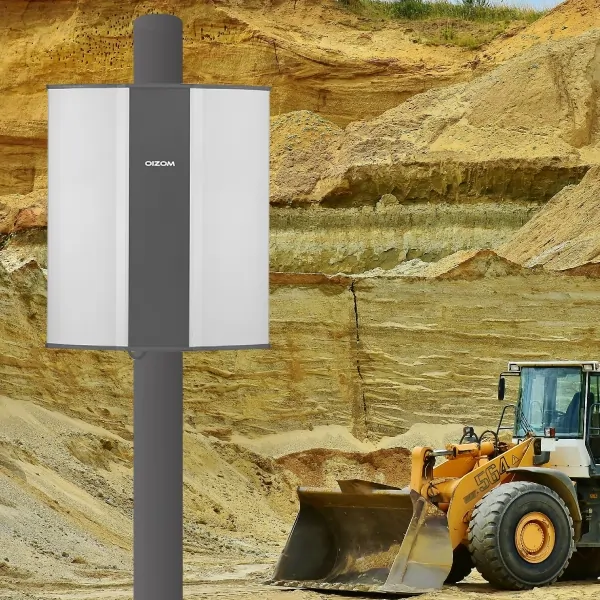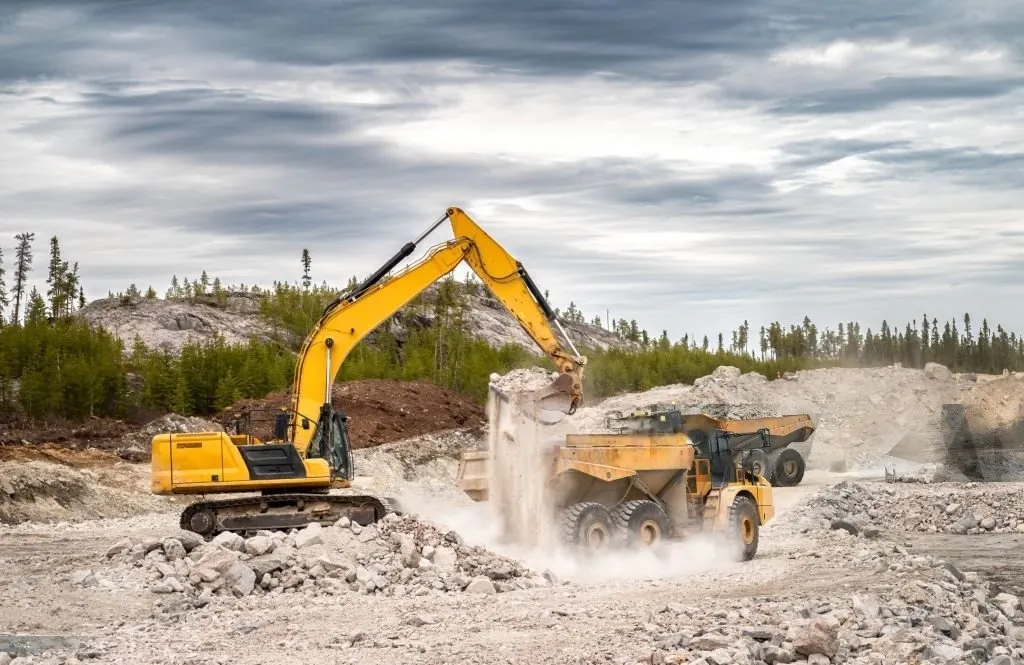Key Takeaway Points
- Good air quality is essential for health, the environment, and the economy. Poor air quality impacts human health, vegetation, and the livability of cities.
- The Central Pollution Control Board (CPCB) sets standards and guidelines to monitor and control air pollution across India.
- NAAQS includes guidelines for both manual and automatic monitoring of pollutants like PM10, PM2.5, SO2, NO2, CO, O3, and others.
- Air (Prevention and Control of Pollution) Act 1981 outlines the responsibilities of CPCB and State Pollution Control Boards in maintaining air quality.
- Manual methods for pollutants include gravimetric methods for PM10 and PM2.5 and chemical analyses for gases. Automatic analyzers use chemiluminescence, NDIR, UV fluorescence, and BAM for real-time monitoring.
- Sampling sites should be chosen carefully to avoid inaccurate readings. Locations must be away from large pollution sources and should have free airflow and shelter.
- Regular monitoring of pollutants like CO, SO2, NO2, SPM, and RSPM is essential, with specific guidelines for industrial and densely populated areas.
- To understand pollution patterns, key meteorological parameters such as wind speed, direction, humidity, temperature, rainfall, and air pressure must be measured.
- Real-time monitoring is crucial for effective pollution control but poses challenges, especially in urban and industrial areas.
- The government uses a combination of regulatory, technological, innovative, and integrated control techniques to improve air quality, supported by updated NAAQS guidelines.
CPCB Guidelines for Ambient Air Quality Monitoring: What You Need to Know
In our previous article, we delved into the National Air Quality Monitoring Program. Today, we’re diving into the latest CPCB ambient air quality monitoring guidelines. You might be wondering why this is so important, but have you ever stopped to think about air pollution and its impact on our environment and health? Here’s a quick fact for you: air pollution is now the second leading risk factor for death worldwide. Pretty alarming, right? Let’s explore why these guidelines matter and how they help us tackle this pressing issue.
Importance of good air quality
Air quality measures the suitability of air for breathing by humans, plants, and animals.
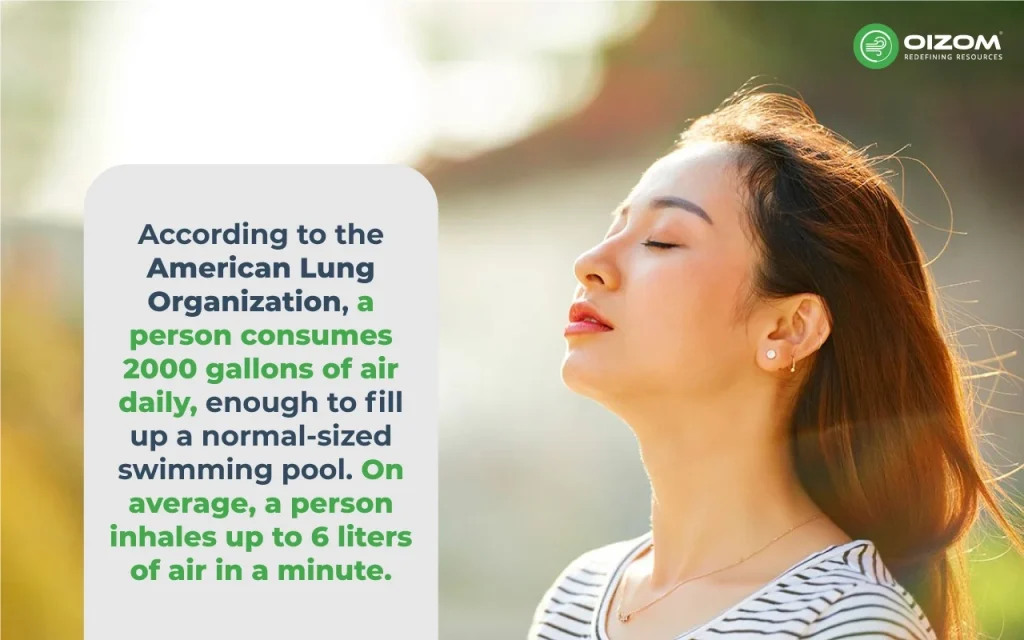
Poor air quality can impact current and future generations’ quality of life by influencing health, the environment, the economy, and the livability of cities.
Good outdoor air quality is essential to our health. A healthy environment is crucial for the right to life, affecting both humans and other species. Violations of the right to a healthy environment can compromise the fundamental right to life.
Air (Prevention and Control of Pollution) Act 1981
The Government of India enacted the Air (Prevention and Control of Pollution) Act 1981 to address poor air quality. The law outlines responsibilities for the Central Pollution Control Board (CPCB) at the national level and State Pollution Control Boards at the state level.
What is National Ambient Air Quality Standards (NAAQS)
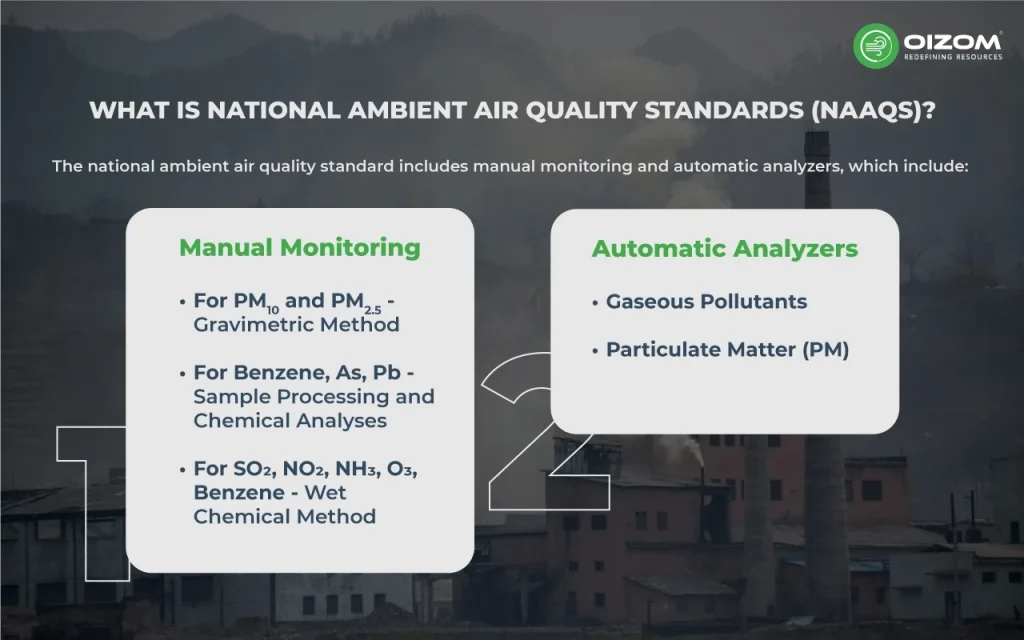
The National Air Quality Monitoring Program (NAMP), managed by the Central Pollution Control Board, is an extensive initiative to monitor ambient air quality throughout the entire nation. It involves systematically measuring air pollution levels, monitoring changes over time, and providing data to aid in developing air quality improvement plans. This program is critical for understanding how air pollution affects human health and the environment and assuring compliance with air quality standards and laws.
The objectives of air quality standards are:
- To indicate the air quality levels necessary with an adequate margin of safety to protect the public health, vegetation, and property.
- To assist in establishing priorities for abatement and control of pollutant levels.
- To provide a uniform yardstick for assessing air quality at the national level.
- To indicate the need and extent of the monitoring program.
The national ambient air quality standard includes manual monitoring and automatic analyzers, which include:
Manual Monitoring:
- For PM10 and PM2.5 – Gravimetric Method,
- For Benzene, As, Pb – Sample Processing and Chemical Analyses.
- For SO2, NO2, NH3, O3, Benzene – Wet Chemical Method.
Automatic Analyzers: CPCB focuses on monitoring several key pollutants, and different analyzers are used for each:
- Gaseous Pollutants: Analyzers based on chemiluminescence, non-dispersive infrared (NDIR), and ultraviolet (UV) fluorescence principles are used for gasses like SO2, NO2, O3, and CO.
- Particulate Matter (PM): Beta attenuation monitors (BAM) are commonly used for continuous PM10 and PM2.5 measurements. TEOM (Tapered Element Oscillating Microbalance) analyzers are another option.
Ambient Air Quality monitoring guidelines
The Central Pollution Control Board (CPCB) plays an important role in India by developing and enforcing air quality guidelines. As our cities expand and industrialization accelerates, the necessity for strict measures to monitor and regulate air pollution grows. Implementing real-time data collecting and monitoring systems for ambient air quality is one of the most important tools for reaching this goal.
The CPCB sets ambient air quality regulations to protect public health and the environment from pollutants such as particulate matter (PM10 and PM2.5), nitrogen dioxide (NO2), sulfur dioxide (SO2), carbon monoxide (CO), ozone (O3), ammonia (NH3), and lead. These criteria are based on considerable research considering the potential health concerns of various pollutants.
National Ambient Air Quality Standards
- The mandate provided to the CPCB under the Air (Prevention and Control of Pollution) Act empowers it to set standards for air quality.
- The current National Ambient Air Quality Standards were notified on 18 November 2009 by the Central Pollution Control Board.
| Pollutant | Time Weighted Average | Ecologically Sensitive Area (notified by Central Government) | Industrial, Residential, Rural, and Other Areas |
|---|---|---|---|
| Sulfur Dioxide (SO2), µg/m3 | Annual* 24 hours** | 50 80 | 20 80 |
| Nitrogen Dioxide (NO2), µg/m3 | Annual* 24 hours* | 40 80 | 30 80 |
| Particulate Matter (size less than 10 µm) or PM10 µg/m3 | Annual* 24 hours | 60 100 | 60 100 |
| Particulate Matter (size less than 2.5 µm) or PM2.5 µg/m3 | Annual* 24 hours** | 40 60 | 40 60 |
| Ozone (O3) µg/m3 | 8 hours* 1-hour** | 100 180 | 100 180 |
| Lead (Pb) µg/m3 | Annual* 24 hours** | 0.50 1.0 | 0.50 1.0 |
| Carbon Monoxide (CO) mg/m3 | 8 hours* 1-hour** | 02 04 | 02 04 |
| Ammonia (NH3) µg/m3 | Annual* 24 hours** | 100 400 | 100 400 |
| Benzene (C6H6) µg/m3 | Annual* | 5 | 5 |
| Benzo(a)Pyrene (BaP)- particulate phase only, ng/m3 | Annual* | 1 | 1 |
| Arsenic(As), ng/m3 | Annual* | 6 | 60 |
| Nickel (Ni), ng/m3 | Annual* | 20 | 20 |
| * Annual arithmetic mean of minimum 104 measurements in a year at a particular site taken twice a week 24 hourly at uniform intervals. ** 24 hourly or, 8 hourly or 1 hourly monitored values, as applicable, shall be complied with 98% of the time. They may exceed the limits but not on two consecutive days of monitoring. Source: National Ambient Air Quality Standards, Central Pollution Control Board Notification in the Gazette of India, Extraordinary, New Delhi, 18th November, 2009 | |||
Challenges in Achieving Air Quality Standards:
Meeting these air quality criteria presents numerous obstacles, particularly in densely populated urban and industrial areas. Traditional monitoring approaches frequently use periodic sampling, which may not capture the dynamic character of air quality. Real-time air quality monitoring is critical for quickly identifying pollution sources, assessing the effectiveness of control measures, and issuing timely warnings to citizens.
Guidelines for Selection of Monitoring Location
Ambient air quality should be monitored in regions where pollution is present or expected, such as industrial regions, traffic crossroads, densely populated places, and so on. The sample point should be carefully chosen because an inappropriate location may result in a high or low concentration of pollutants in the air, which will fail to achieve the purpose of Ambient Air Quality monitoring.
The following are the Ambient Air Quality monitoring criteria for the selection of sampling points:
- The site should be at least 25 meters away from large pollution sources, such as chimneys and stacks.
- The spot should be away from absorbent materials or surfaces.
- The site chosen for monitoring should be available (no reconstruction or new construction) for a long period, i.e., years, because a change in the Air Quality Monitoring Station may mislead trends.
- It should be placed where free airflow is available. It should be open from all sides.
- While sampling traffic data, it is recommended that the sampling instrument should be 3m above the ground as it can absorb unnecessary particles which are non-pollutants
- Instruments should be sampled 200m away from unpaved roads. This will prevent dust from entering the instruments from vehicle movement.
- The site should have sheltering, electricity, water, etc.
- The distance of the sampling point from the road depends on the number of vehicles running on that road.
- The sampler must be at least 20 m away from trees.
- The distance of the sampler from any building should be double the height of the building from the sampler.
Guidelines for Selection of Pollutants
Carbon monoxide, SO2, NO2, SPM, and RSPM are often measured regularly. According to the Ambient Air Quality Monitoring Guidelines, if the monitoring area is industrial, the predicted pollutants must also be measured regularly.
Polycyclic aromatic hydrocarbons (PAHs) and ozone levels can be monitored if resources are available.
- In densely populated and heavily traffic locations, SO2, NO2, RSPM, SPM, and CO levels can be monitored.
- In industrial areas, RSPM/PM10 SO2 can be monitored.
- SPM can be used to monitor soil-borne dust caused by construction operations.
- Ozone can be monitored in Areas with downwind flow because Ozone O3 is present in the upper layer of the atmosphere. It is created by interactions between contaminants in the atmosphere.
Previous Air Quality Information
Any previous information collected on ambient air quality can serve as a basis for selecting areas where monitoring should be conducted, and previous studies may include data collected for health studies, etc. Previous studies can be used to estimate the magnitude of the problem. Once the background information is collected, ambient air quality monitoring is to be initiated, and the selection of the type of pollutant to be measured, number and distribution of monitoring stations, etc., should be made.
Guidelines for meteorological Measurements
Meteorology is a key tool in the investigation of air pollution. It is required to measure meteorological parameters. Wind speed and direction, humidity, temperature, rainfall, and air pressure are all important meteorological characteristics to measure.
Conclusion
In conclusion, the government has implemented a multifaceted approach to improving air quality in the country, including regulatory, technological, innovative, and integrated control techniques. In 2009, the Revised National Ambient Air Quality Standards (NAAQS) were notified for 12 pollutants to protect human and ecological health. In summary, this blog explains the basic guidelines for ambient air quality monitoring of CPCB with reference to the latest guidelines published by CPCB. In conclusion, I hope this article explains CPCB’s ambient air quality monitoring guidelines. I just want to convey this message that after reviewing and demonstration in the Central Laboratory, Delhi, guidelines are being prepared and documented, as under Volume -I: Guidelines for manual sampling and analyses (along with sample flow chart and data sheets); Volume-II: Guidelines for continuous sampling and real-time analyses.

